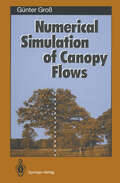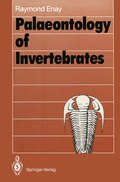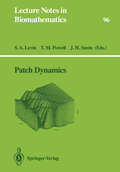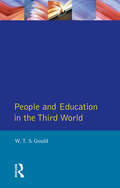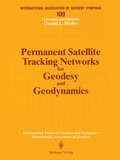- Table View
- List View
Nonequilibrium Problems in Many-Particle Systems: Lectures given at the 3rd Session of the Centro Internazionale Matematico Estivo (C.I.M.E.) held in Monecatini, Italy, June 15-27, 1992 (Lecture Notes in Mathematics #1551)
by L. Arkeryd P-L. Lions P. A. Markowich S.R.S. VaradhanThis volume contains the text of four sets of lectures delivered at the third session of the Summer School organized by C.I.M.E. (Centro Internazionale Matematico Estivo). These texts are preceded by an introduction written by C. Cercignani and M. Pulvirenti which summarizes the present status in the area of Nonequilibrium Problems in Many-Particle Systems and tries to put the contents of the different sets of lectures in the right perspective, in order to orient the reader. The lectures deal with the global existence of weak solutions for kinetic models and related topics, the basic concepts of non-standard analysis and their application to gas kinetics, the kinetic equations for semiconductors and the entropy methods in the study of hydrodynamic limits. CONTENTS: C. Cercignani, M. Pulvirenti: Nonequilibrium Problems in Many-Particle Systems. An Introduction.- L. Arkeryd: Some Examples of NSA in Kinetic Theory.- P.L. Lions: Global Solutions of Kinetic Models and Related Problems.- P.A. Markowich: Kinetic Models for Semiconductors.- S.R.S. Varadhan: Entropy Methods in Hydrodynamic Scaling.
Nonlinear Evolution of Spatial Economic Systems
by Peter Nijkamp Aura ReggianiIs our world more dynamic than it used to be in the past? Have phenomena in the social science field become unpredictable? Are chaotic events nowadays occurring more frequently than in the past? Such questions are often raised in popular debates on nonlinear evolution and self-organizing systems. At the same time, many scientists are also raising various intruiging methodological issues. Is it possible to separate deterministic chaos from random disturbances if their trajectories are (almost) similar? Is prediction still possible in a world of chaos (Poincare)? Is it possible to distinguish specification errors from measurement errors in a nonlinear dynamic model? Is evolution a random process? The list of such questions can easily be extended with dozens of others. But despite the myriad of questions on problems of nonlinear evolution, one common trait is evident: in both the natural and the social sciences we are still groping in the dark in areas which are par excellence promising hunting grounds for exploratory and exploratory research, viz. structural grounds in an uncertain nonlinear world. The present book aims at offering a collection of refreshing contributions to the above research issues by focusing attention, in particular on nonlinear dynamic evolution in space at the Netherlands Institute for Advanced Study (NIAS) in Wassenaar, the Netherlands. The Institute has to be thanked for its hospitality and support, reflected inter alia in a workshop at which several of the papers included in this book were discussed.
Nonlinear Processes in Physics: Proceedings of the III Potsdam — V Kiev Workshop at Clarkson University, Potsdam, NY, USA, August 1–11, 1991 (Springer Series in Nonlinear Dynamics)
by A. S. Fokas D. J. Kaup A. C. Newell V. E. ZakharovIn 1979, a historical meeting took place at the Institute for Theoretical Physics in Kiev, USSR, where 48 American Scientists, specialists in nonlinear and turbulent processes, met for two weeks with their soviet counterparts. This meeting pro vided the unique opportunity for USA and USSR participants to directly interact personally and scientifically with each other. This interaction was of great impor not only for the individuals involved but also for the science of nonlinear tance phenomena in general. At the end of the meeting, it was agreed that this exchange should continue, and it was decided to have the next meeting in the USA in 1981. Unfortunately, due to the political situation at that time, the second meeting in the USA never materialized. However, in 1983, the Soviet scientists organized in Kiev a second Workshop. This second meeting was again quite successful. Similar meetings, with growing success were organized at Kiev in 1987, and 1989. It should be noted that 405 participants from 22 countries participated at the fourth Kiev workshop on Nonlinear and Turbulent Processes. The Chainnan of this workshop was V. Zakharov, who has also been a co-chainnan of all the previous workshops.
Nonlinear Waves and Weak Turbulence: with Applications in Oceanography and Condensed Matter Physics (Progress in Nonlinear Differential Equations and Their Applications #11)
by FITZMAURICE GURARIE MCCAUGHAN WOYCZYNSKIThis book is an outgrowth of the NSF-CBMS conference Nonlinear Waves £3 Weak Turbulence held at Case Western Reserve University in May 1992. The principal speaker at the conference was Professor V. E. Zakharov who delivered a series of ten lectures outlining the historical and ongoing developments in the field. Some twenty other researchers also made presentations and it is their work which makes up the bulk of this text. Professor Zakharov's opening chapter serves as a general introduction to the other papers, which for the most part are concerned with the application of the theory in various fields. While the word "turbulence" is most often associated with f:l. uid dynamics it is in fact a dominant feature of most systems having a large or infinite number of degrees of freedom. For our purposes we might define turbulence as the chaotic behavior of systems having a large number of degrees of freedom and which are far from thermodynamic equilibrium. Work in field can be broadly divided into two areas: • The theory of the transition from smooth laminar motions to the disordered motions characteristic of turbulence. • Statistical studies of fully developed turbulent systems. In hydrodynamics, work on the transition question dates back to the end of the last century with pioneering contributions by Osborne Reynolds and Lord Rayleigh.
Nuclear Magnetic Shieldings and Molecular Structure (Nato Science Series C: #386)
by J. A. TossellModern approaches to the theoretical computation and experimental determination of NMR shielding tensors are described in twenty-nine papers based on lectures presented at the NATO ARW. All of the most popular computational methods are reviewed and recent progress is described in their application to chemical, biochemical, geochemical and materials science problems. Experimental studies on NMR shieldings in gases, liquids and solids are also included, with special emphasis placed upon the relationship between NMR shielding and geometric structure and upon tests of the accuracy of the various computational methods. Qualitative MO schemes and semiempirical approaches are also considered in light of the computational results. This is a valuable book for anyone interested in how the NMR shielding tensor can be used to determine the geometric and electronic structures of molecules and solids. (abstract) Modern methods for computing and measuring nuclear magnetic resonance shielding tensors are described in papers by a great number of leaders in the field. The most popular methods for quantum mechanically calculating NMR shielding tensors are reviewed and many applications of these methods are described to problems in chemistry, biochemistry, geochemistry and materials science. The focus of the papers is on the relationship of the NMR shielding tensor to the geometric and electronic structure of molecules or solids.
Numerical Simulation of Canopy Flows (Springer Series in Physical Environment #12)
by Günter GroßStarting with the description of meteorological variables in forest canopies and its parameter variations, a numerical three-dimentional model is developed. Its applicability is demonstrated, first, by wind sheltering effects of hedges and, second, by the effects of deforestation on local climate in complex terrain. Scientists in ecology, agricultural botany and meteorology, but also urban and regional lanners will profit from this study finding the most effective solution for their specific problems.
Nutrient Dynamics and Retention in Land/Water Ecotones of Lowland, Temperate Lakes and Rivers (Developments in Hydrobiology #82)
by A. Hillbricht-Ilkowska E. PieczynskaEcotones, or boundary zones between land and inland waters (such as lakes, streams and rivers), are the principal routes for transport of organic matter and nutrients across landscapes via physical and biological vectors. The ecotone is the place of cumulation and transformation of in situ production as well as of allochthonous material from adjacent aquatic and terrestrial systems. The ecotype functions as an important barrier or filter for principal nutrients, such as phosphorus and nitrogen, responsible for the eutrophication and degradation of surface waters. Intensive forest cutting, agriculture, pollution and bank regulation, urbanization and hydrotechnical constructions seriously endanger the ecotone systems and damage their protective function. It is vital to develop a scientific understanding of the behaviour of phosphorus and nitrogen in these transitional boundary habitats. Such an understanding is important for the rational protection, management and restoration of ecotones connected with lakes and rivers. The importance of nutrient cycling and retention is discussed from the point of view of ecotone function, management and reconstruction in order to sustain its protective role for water bodies. Various types of land/water transitory zones are discussed: wetlands, lake littoral systems, riparian zones of rivers, streams and brooks, the contact zones between groundwater and surface waters of lakes and rivers, air--water interfaces, and patch/ecotone structures in watersheds.
Ocean Colour: Theory and Applications in a Decade of CZCS Experience (Eurocourses: Remote Sensing #3)
by Vittorio Barale and Peter M. SchlittenhardtOptical remote sensing is of invaluable help in understanding the marine environment and its biogeochemical and physical processes. The Coastal Zone Color Scanner (CZCS), which operated on board the Nimbus-7 satellite from late 1978 to early 1986, has been the main source of ocean colour data. Much work has been devoted to CZCS data processing and analysis techniques throughout the 1980s. After a decade of experience, the Productivity of the Global Ocean (PGO) Activity - which was established in the framework of the International Space Year 1992 (ISY '92) by SAFISY, the Space Agency Forum of ISY - sponsored a workshop aimed at providing a reference in ocean colour science and at promoting the full exploitation of the CZCS historical data in the field of biological oceanography. The present volume comprises a series of state-of-the-art contributions on theory, applications and future perspectives of ocean colour. After an introduction on the historical perspective of ocean colour, a number of articles are devoted to the CZCS theoretical background, on radiative transfer and in-water topics, as well as on calibration, atmospheric correction and pigment concentration retrieval algorithms developed for the CZCS. Further, a review is given of major applications of CZCS data around the world, carried out in the past decade. The following part of the book is centered on the application of ocean colour to the assessment of marine biological information, with particular regard to plankton biomass, primary productivity and the coupling of physical/biological models. The links between global oceanic production and climate dynamics are also addressed. Finally, the last section is devoted to future approaches and goals of ocean colour science, and to planned sensors and systems. The book is required reading for those involved in ocean colour and related disciplines, providing an overview of the current status in this field as well as stimulating the debate on new ideas and developments for upcoming ocean colour missions.
Offshore Site Investigation and Foundation Behaviour: Papers presented at a conference organized by the Society for Underwater Technology and held in London, UK, September 22–24, 1992 (Advances in Underwater Technology, Ocean Science and Offshore Engineering #28)
by J. M. Squire R. J. Jardine R. Hobbs A. Hill D. Clare D. A. ArdusTwo main areas of offshore activity are addressed in this book: Site investigation on assessment; and Applications and foundation engineering. The 37 contributions from a wide ranging group of international experts, are resulting from the Offshore Site Investigation and Foundation Behaviour Conference, London, U.K., September 1992. Adequate determination of site conditions can only be achieved by the integrated approach of using geological, geophysical and geotechnical data. Developments in data acquisition techniques are illustrated through case histories in the section on Geotechnical Sampling and Testing. In the section on Advanced Interpretation Techniques and Integrated Interpretations the state of the art of these topics is also illustrated by case histories. A review of foundation behaviour is presented in the section on Gravity Foundations, Foundation Performance Monitoring, Piling Research and Design Criteria. These topics are illustrated in the light of field experience and recent research, in particular that involving full-scale tests and monitoring. This book provides many illustrative figures and much pertinent information to exploration and marine geophysicists, petroleum and offshore engineers and for researchers working these fields.
An Open Systems Approach to Quantum Optics: Lectures Presented at the Université Libre de Bruxelles, October 28 to November 4, 1991 (Lecture Notes in Physics Monographs #18)
by Howard CarmichaelThis volume contains ten lectures presented in the series ULB Lectures in Nonlinear Optics at the Universite Libre de Bruxelles during the period October 28 to November 4, 1991. A large part of the first six lectures is taken from material prepared for a book of somewhat larger scope which will be published,by Springer under the title Quantum Statistical Methods in Quantum Optics. The principal reason for the early publication of the present volume concerns the material contained in the last four lectures. Here I have put together, in a more or less systematic way, some ideas about the use of stochastic wavefunctions in the theory of open quantum optical systems. These ideas were developed with the help of two of my students, Murray Wolinsky and Liguang Tian, over a period of approximately two years. They are built on a foundation laid down in a paper written with Surendra Singh, Reeta Vyas, and Perry Rice on waiting-time distributions and wavefunction collapse in resonance fluorescence [Phys. Rev. A, 39, 1200 (1989)]. The ULB lecture notes contain my first serious atte~pt to give a complete account of the ideas and their potential applications. I am grateful to Professor Paul Mandel who, through his invitation to give the lectures, stimulated me to organize something useful out of work that may, otherwise, have waited considerably longer to be brought together.
Optical Properties of Low Dimensional Silicon Structures (NATO Science Series E: #244)
by B. Bensahel Leigh T. Canham Stephano OssiciniThe workshop on "Optical Properties of Low Dimensional Silicon sL Structures" was held in Meylan, France on March, I yd, 1993. The workshop took place inside the facilities of France Telecom- CNET. Around 45 leading scientists working on this rapidly moving field were in attendance. Principal support was provided by the Advanced Research Workshop Program of the North Atlantic Treaty Organisation (NATO). French Delegation a l'Armement and CNET gave also a small financial grant, the organisational part being undertaken by the SEE and CNET. There is currently intense research activity worldwide devoted to the optical properties of low dimensional silicon structures. This follow the recent discovery of efficient visible photoluminescence (PL) from highly porous silicon. This workshop was intended to bring together all the leading European scientists and laboratories in order to reveal the state of the art and to open new research fields on this subject. A large number of invited talks took place (12) together with regular contribution (20). The speakers were asked to leave nearly 1/3 of the time to the discussion with the audience, and that promoted both formal and informal discussions between the participants.
Optimization of Plant Nutrition: Refereed papers from the Eighth International Colloquium for the Optimization of Plant Nutrition, 31 August – 8 September 1992, Lisbon, Portugal (Developments in Plant and Soil Sciences #53)
by M. A. Fragoso M. L. Van BeusichemThe world-wide shortage of plant production menacing the survival of many people demands for more and better research, particularly on how to increase food and where it is most needed. Major problems of international concern for the scientific community are the availability in soil media of macro and micro nutrients and the efficiency of nutrient uptake by plant roots, the interactions between nutrients and other factors, the distribution of nutrients in different plant species, biochemical functions of nutrient elements, and their contribution to plant growth, yield and product quality. Feasibility and profit are also permanent concerns about plant nutrition in crop management, to which new require ments are now imposed by the need to decrease pollution hazards, a problem of prime importance to preserve the environment of the future. is A deeper insight into basic knowledge further required as well as into practical problems in the domains of agriculture, horticulture, and forestry. Such has been the concern of the International Association for the Optimization of Plant Nutrition (IAOPN) since 1964, promoting International Colloquia every four years as an opportunity for scientists concerned with plant nutrition to report new findings and to exchange ideas, experiences, and techniques. The Eighth International Colloquium for the Optimization of Plant Nutrition was hosted by Portugal and held in Lisbon from 31 August to 8 September 1992, with 280 delegates from 34 countries.
Ore Geology and Industrial Minerals: An Introduction (Geoscience Texts)
by Anthony M. EvansMuch new data and many new ideas have emerged in the area of ore geology and industrial minerals since publication of the second edition of this text in 1987. The overriding philosophy behind this new edition is the inclusion and integration of this new material within the established framework of the text. The third edition is re-presented in the modern double-column format. Non-metallic deposits of industrial and bulk materials are fully covered to meet the changing emphasis of courses in applied geology. In addition, chapter 1 has been considerably enlarged to include a section on mineral economics covering metals, industrial minerals and bulk materials. In this section, the various aspects of economic exploitation of industrial and bulk materials are compared with those of metallic deposits. Other major revisions and additions include a section on fluid inclusions, expansion of the section on wall rock alteration, expansion of the material on isotope studies, and the inclusion of a section on hydraulic fracturing and seismic pumping.
The Origin of Structure in the Universe (Nato Science Series C: #393)
by E. Gunzig P. NardoneEdgard Gunzig and Pasquale Nardone RGGR Universite Libre de Bruxelles CP231 1050 Bruxelles Belgium The NATO Advanced Research Workshop on "The Origin of Structure in the Universe" was organized to bring together workers in various aspects of relativistic cosmology with the aim of assessing the present status of our knowledge on the formation and evolution of structure. As it happened, the meeting was particularly timely. Only two days before the 30 or so physicists from many countries gathered for a week at the Chateau du Pont d'Oye, in the forests of the southern Belgian province of Luxembourg, newspaper headlines all over the world announced the results of the analysis of the first full year of data from the Cosmic Background Observer Satellite (COBE). This long-awaited confirmation of the theoretically predicted anisotropy in the microwave background radiation opened a new era in observational cos mology. The realization of the new relevance of the subject of the workshop and the questions raised by the observational results, in addition to bring ing TV crews and newspaper journalists, naturally influenced and stimulated many discussions among the participants. The success of the meeting as usual is due to a combination of factors. Besides the high quality of the talks, discussions were encouraged by the warm atmosphere of the Chateau, for which we are grateful to Mme. Camille Orts, and its beautiful surroundings, not to mention the marvelous cuisine.
Palaeontology of Invertebrates
by Raymond EnayHow could life have started on Earth and how did it proceed? After a short discussion on the origin of life on Earth and the origin of the major body plans the invertebrates are presented in the order of increasing complexity by the most significant fossil representatives. In each case, the adaptive significance of the respective forms and/or structures which more or less profoundly changed the original body plan is treated in detail. In the closing chapter, some general aspects of invertebrates in evolution and palaeoecology, palaeobiogeography and biochronology are outlined.
Partial Differential Equations IV: Microlocal Analysis and Hyperbolic Equations (Encyclopaedia of Mathematical Sciences #33)
by Yu. V. Egorov V. Ya. IvriiA two-part monograph covering recent research in an important field, previously scattered in numerous journals, including the latest results in the theory of mixed problems for hyperbolic operators. The book is hence of immense value to graduate students and researchers in partial differential equations and theoretical physics.
Particle Production in Highly Excited Matter (Nato Science Series B: #303)
by Hans H. Gutbrod Johann RafelskiSeven years after the first experiments in the new field of Nuclear Physics, the Highly Relativistic Heavy Ion Physics, the Nato-Advanced- Study-Institute on the 'Particle Production in Highly Excited Matter' was held from July 12 till July 24, 1992, at Il Ciocco, Castelvecchio Pascoli, near Lucca in Italy. The school took place at a mo ment when intensive efforts are mounted by the scientific community of Relativistic Heavy Ion Physics to meet the extraordinary challenge of the new upcoming physics opportunities. The gold beams of 10 GeV A at Brookhaven AGS have been sent to the experiments this Summer and we extent our congratulations to the persons and teams who made this possible. The Relativistic Heavy Ion Collider (RHIC) at Brookhaven is under construction and expected to allow experiments to see collisions in the intersec tion regions early 1998. The lead beams at the SPS at CERN scheduled for summer 1994 are eagerly awaited by 6 large experiments, and many scientists are planning the experiments at the planned LHC with heavy ions to be turned on before the year 2000. Seen against this background of rather fierce activity, we were most delighted when NATO accepted our application for an Advanced Study Institute oriented to the main subject of this young and dynamic field of research. We are very grateful to the Scientific Affairs Division of NATO and Dr. L. DaCunha, the director of the Advanced Study Institute program for giving our community this opportunity.
Patch Dynamics (Lecture Notes in Biomathematics #96)
by Simon A. Levin Thomas M. Powell John H. SteeleFrom the preface by Joel E. Cohen: "A century from now humanity will live in a managed - or mismanaged - global garden. We are debating the need to preserve tropical forests. Farming of the sea is providing an increasing part of our fish supply. We are beginning to control atmospheric emissions. In 100 years, we shall use novel farming practices and genetic engineering of bacteria to manipulate the methane production of rice fields. The continental shelf will be providing food, energy, possibly even living space. To make such intensive management possible will require massive improvements in data collection and analysis, and especially in our concepts. A century hence we will live on a wired earth: the oceans and the crust of the earth will receive the same comprehensive monitoring now devoted to weather. As the peoples of currently developing countries increase their levels of wealth, the need for global management will become irresistible as impatience with the accidents of nature and intolerance of mismanagement of the environment - especially of living resources - grow. Our control of physical perturbations and chemical inputs to the environment will be judged by the consequences to living organisms and biological communities. How can we obtain the factual and theoretical foundation needed to move from our present, fragmented knowledge and limited abilities to a managed, global garden?" This problem was addressed in the lectures and workshops of a summer school on patch dynamics at Cornell University. The school emphasized the analysis and interpretation of spatial patterns in terrestrial and marine environments. This book contains the course material of this school, combining general reviews with specific applications.
People and Education in the Third World
by W. T. GouldFirst published in 1993. Routledge is an imprint of Taylor & Francis, an informa company.
People and Education in the Third World
by W. T. GouldFirst published in 1993. Routledge is an imprint of Taylor & Francis, an informa company.
Permanent Satellite Tracking Networks for Geodesy and Geodynamics: Symposium No. 109 Vienna, Austria, August 11–24, 1991 (International Association of Geodesy Symposia #109)
As the Global Positioning System (GPS) satellite array nears complete configuration, the versatility of the system is becoming apparent. Using GPSin combination with other techniques, such as PARE, DORIS, SLR, and VLBI allows for quick and highly accurate determinations of orbits, earth rotation, and crustal deformation. The papers in this volume examine the virtues of permanent satellite tracking networks and review the standards of GPS observation and analysis in geodesy and geodynamics. The papers presented in this volume are the result of an IAG symposium held during the XX General Assembly of the International Union of Geodesy and Geophysics in Vienna, Austria, August 11-24, 1991.
Perspektiven menschlichen Handelns: Umwelt und Ethik
by K. Töpfer Karl-Heinz ErdmannIm interdisziplinären Dialog diskutieren Vertreter aus Theologie, Philosophie, Geographie, Pädagogik, Psychologie und Verhaltenswissenschaft beispielhaft ethische Fragestellungen zum Umgang des Menschen mit Natur und Umwelt. In diesem Zusammenhang wird Ethik als richtungsweisendes Konzept zur Realisierung neuer Wertorientierungen verstanden. Aufbauend auf den verschiedenen wissenschaftlichen Betrachtungsweisen der beteiligten Fachdisziplinen werden vielfältige Möglichkeiten zur Förderung umweltgerechten Verhaltens aufgezeigt und konkrete Wege zur Lösung dieser umfassenden Menschheitsfrage entwickelt.
Physik: Ein Lehrbuch zum Gebrauch neben Vorlesungen (Springer-Lehrbuch)
by Christian Gerthsen Helmut VogelDie siebzehnte Auflage des Gerthsen ist zugleich die sechste in der Bearbeitung Helmut Vogels. Der Autor bereichert das klassische Studien- und Nachschlagewerk mit einem neuen Kapitel zur nichtlinearen Dynamik (auch Chaos und Fraktale werden besprochen) sowie acht instruktiven Farbtafeln. Daneben gibt es wieder kleinere Ergänzungen und Korrekturen. Wo die Darstellung wegen der selbstauferlegten Beschränkung im Umfang nicht alle Themen behandeln kann, helfen die mehr als zahlreichen Übungsaufgaben, die im Band Vogel, Probleme aus der Physik, ISBN 3-540-51217-9, mit Beiheft nun auch zur 17. Auflage verwendbar, ausführlich besprochen werden.





